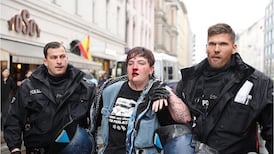Ihor Zastavnyi moves quickly on his crutch like a young man impatient to cast it aside, perhaps a footballer nursing a knee injury or a cyclist on the mend after a scrape.
But the 20-year-old will never recover fully from the damage he suffered on February 20th in Kiev, when bullets flew on Independence Square.
Zastavnyi was hit in the arm and stomach and then, as he tried to drag himself to safety, a round smashed his lower left leg to pieces. He has just returned to Lviv, in western Ukraine, after having a prosthesis fitted in nearby Poland.
“When my sister saw my new leg, she cried,” Zastavnyi says. “But I don’t regret going to Kiev, because I saw the spirit that people can have. They risked their lives, and died, for something they believed in.”
The carpenter made for the capital after seeing pictures of how riot police beat students there last November 30th, as they protested against then- president Viktor Yanukovich’s rejection of a historic pact with the EU.
Spiralling movement Zastavnyi returned to Lviv after a few days, but felt compelled to rejoin a spiralling protest movement that would ultimately send Yanukovich and his clique fleeing for Russia less than three months later.
“I put three litres of borshch soup in my rucksack and headed back to Maidan,” he says, using the popular name for Independence Square.
His lip was split by a rubber bullet, and he suffered mild frostbite in his fingers and toes as demonstrations ground on through the winter, and as Yanukovich sought to cement power by repairing strained ties with Russia.
When, in January, the first deadly violence erupted between protesters and riot police, Zastavnyi did not flinch.
“I threw rocks at the riot police, but if I’d had Molotov cocktails I would have thrown them too,” he says, without bravado. “People did as they saw fit. No one was listening to the politicians. The people took control and decided how to act.”
Zastavnyi did not tell his parents what he was doing in Kiev, but went home in February when he heard his father was ill. He died a few days later. The family was in mourning, and Kiev was soon in flames.
When Zastavnyi learned of deadly shooting on Maidan on February 18th, he returned to the capital. The next morning, he found the protest headquarters gutted, tents reduced to ash and riot police threatening to crush all resistance.
The next day his life, and perhaps his country, changed forever. “In the morning we moved up Instytutska Street towards the riot police, with our guys throwing petrol bombs and rocks at them.
“Then a lad in front of me dropped to the ground, shot. His chest was covered in blood. I put my shield over him and some guys came up and took him away. He must have only been a couple of years older than me. I didn’t cry when my dad died, but I cried then.”
Zastavnyi remembers flying into a rage. He only saw one protester with a gun, he says, but if he had got hold of one himself, he would have used it.
As tear gas canisters rained down on them, Zastavnyi and his comrades crouched down behind their shields, hoping in vain that the thin sheets of wood and metal would protect them from sniper fire.
“A terrible pain suddenly struck my stomach and arm. I thought I’d been hit by rubber bullets again, but when I tried to move, I just couldn’t. I was on my knees, with no protection, and someone tried to help me get away. After going about one metre, an even worse pain hit my leg, and it moved in a strange way. There was blood everywhere and I knew then that I had probably lost it. But I wanted to live.”
When Zastavnyi came round in hospital, he remembered what had happened and reckoned he had only “a one-in-a-hundred chance that my leg was still there. I felt for it, and it was gone.”
Less than a week after the shooting, he was receiving free hospital treatment in Poland. Another demonstrator was in the same clinic, but died from his injuries.
More than 100 people were killed in the protests and hundreds hurt, most the same day as Zastavnyi. He is one of more than 200 people injured on Maidan who have received assistance from a Greek Catholic foundation in Lviv, which collects and distributes donations given by the public to churches in the region.
“Some people lost limbs and eyes, and others suffered psychological problems,” says one of the foundation’s staff, Marta Batryniuk.
“Our country is not wealthy and cannot give them much, so the help we provide is really important.”
Like millions of Ukrainians, Zastavnyi watched in despair as Russia annexed Crimea and pro-Moscow separatists in eastern regions declared independence. But he is confident that Ukraine will ultimately be “better, more open”, after a revolution that was, above all, “for freedom”. “We need new leaders – politics is still all lies and money,” he adds.
Will Zastavnyi make his way to a polling station for Sunday’s presidential election? “Of course,” he exclaims. “But I’ve no idea who to vote for.”











